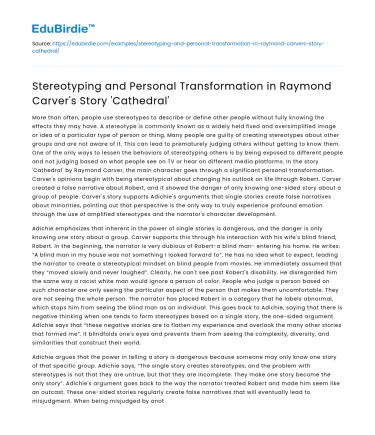More than often, people use stereotypes to describe or define other people without fully knowing the effects they may have. A stereotype is commonly known as a widely held fixed and oversimplified image or idea of a particular type of person or thing. Many people are guilty of creating stereotypes about other groups and are not aware of it. This can lead to prematurely judging others without getting to know them. One of the only ways to lessen the behaviors of stereotyping others is by being exposed to different people and not judging based on what people see on TV or hear on different media platforms. In the story 'Cathedral' by Raymond Carver, the main character goes through a significant personal transformation. Carver's opinions begin with being stereotypical about changing his outlook on life through Robert. Carver created a false narrative about Robert, and it showed the danger of only knowing one-sided story about a group of people. Carver's story supports Adichie's arguments that single stories create false narratives about minorities, pointing out that perspective is the only way to truly experience profound emotion through the use of amplified stereotypes and the narrator's character development.
Adichie emphasizes that inherent in the power of single stories is dangerous, and the danger is only knowing one story about a group. Carver supports this through his interaction with his wife's blind friend, Robert. In the beginning, the narrator is very dubious of Robert-a blind man- entering his home. He writes: “A blind man in my house was not something I looked forward to”. He has no idea what to expect, leading the narrator to create a stereotypical mindset on blind people from movies. He immediately assumed that they “moved slowly and never laughed”. Clearly, he can't see past Robert's disability. He disregarded him the same way a racist white man would ignore a person of color. People who judge a person based on such character are only seeing the particular aspect of the person that makes them uncomfortable. They are not seeing the whole person. The narrator has placed Robert in a category that he labels abnormal, which stops him from seeing the blind man as an individual. This goes back to Adichie, saying that there is negative thinking when one tends to form stereotypes based on a single story, the one-sided argument. Adichie says that “these negative stories are to flatten my experience and overlook the many other stories that formed me”. It blindfolds one's eyes and prevents them from seeing the complexity, diversity, and similarities that construct their world.
Save your time!
We can take care of your essay
- Proper editing and formatting
- Free revision, title page, and bibliography
- Flexible prices and money-back guarantee
Adichie argues that the power in telling a story is dangerous because someone may only know one story of that specific group. Adichie says, “The single story creates stereotypes, and the problem with stereotypes is not that they are untrue, but that they are incomplete. They make one story become the only story”. Adichie's argument goes back to the way the narrator treated Robert and made him seem like an outcast. These one-sided stories regularly create false narratives that will eventually lead to misjudgment. When being misjudged by another, it makes a person feel like they haven't been able to introduce themselves because of a one-sided story. Adichie presented an example in her Ted Talk of when she moved to America to live with her American roommate. Adichie mainly focuses on personal stories to emphasize the pervasiveness of stereotypes; she describes times when a 'single story' was forced upon her. Adichie says, “I was 19. My American roommate was shocked by me”. Her roommate was shocked when she knew how to use essential utilities because she “assumed that I did not know how to use a stove”. Her roommate's single-story was most probably created off of what she has seen on TV, similar to what the narrator assumed of Robert.
Adichie's Ted Talk not only gives personal examples of the danger of single stories, but it supports Carver's character development in the story. Carver writes, “But I had my eyes closed. I thought I'd keep them that way for a little longer. I thought it was something I ought to do. [...] My eyes were still closed. I was at my house. I knew that. But I didn't feel like I was inside anything”. This particular scene in the story is the most significant because it proves that Adichie's argument is valid. The narrator had to take the time to draw the cathedral. He had to think about it and see it in his mind's eye. The narrator finds himself pulled in and adding details to make the picture complete and even drawing some of it with his eyes closed. The narrator recognizes that although his eyes were closed as if he was blind, he can tell how immensely and detailed cathedrals are. This drawing puts him in the same shoes as Robert; although he is blind, he still has sight, he has to visualize it in his mind just as Robert did. This scene is where the narrator realized the importance that comes along with looking past stereotypes and getting to know someone for who they are versus what they are supposed to be. The narrator put himself in a position that made him look at Roberts' side of the story, that although Robert is blind and can't see, he helped a man with perfect vision see what he sees. This opened up a whole new world for the narrator that made him look past the stereotypes, just as Adichie said people should.






 Stuck on your essay?
Stuck on your essay?

